In this article, we’re diving into the Lenovo Yoga Book 9i, a fascinating laptop with two screens and a different design than what you’re used to. Unlike regular laptops, this one doesn’t have a physical keyboard or trackpad. I’m really curious about this product and excited to try it out. It’s not available for purchase yet, so I’m not sure when it will be, but let’s explore what it can do.
Table of Contents
Note: This article contains Amazon affiliate links. If you make a purchase through these links, I may earn a commission at no extra cost to you.
Design and Ports
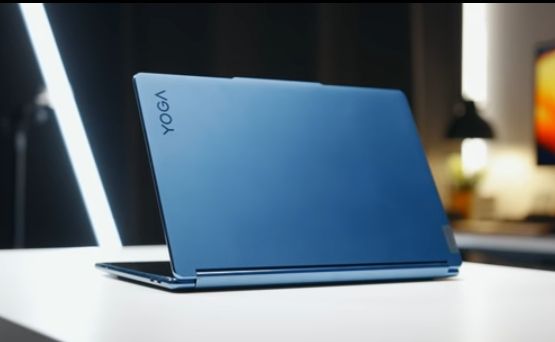
The Lenovo Yoga Book 9i looks a lot like the Pro 9i but with a cool teal color and made of fancy aluminum and feels really nice. The edges are curved so it’s comfy to hold. Even though it’s packed with features, it’s super thin at only 0.63 inches and weighs about 3 pounds, so it’s easy to take with you. And having dual-screens is pretty awesome too!

Now, the port selection on the Lenovo Yoga Book 9i is quite limited. It offers three Thunderbolt 4 ports, which can be utilized for docking purposes or connecting USB-C-compatible peripherals, including displays. While you can use adapters to work with other devices, the absence of additional USB-A ports or an HDMI port can be attributed to the inclusion of the second display. The compact design of the device leaves little space to accommodate larger connectors.
Dual OLED Screens
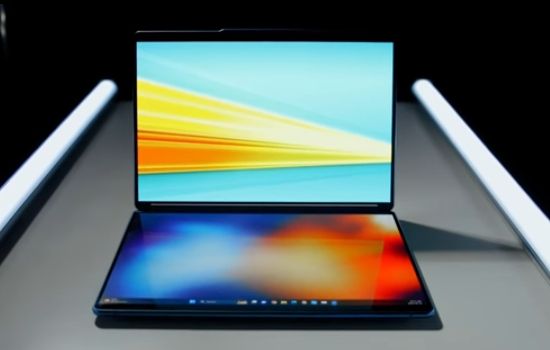
I’ve been trying out this laptop-tablet combo, or you could call it a multi-mode gadget, for a few weeks now and I’ve got some thoughts to share.
First off, let’s talk about the standout feature: the two screens. Normally, laptops have one screen, a keyboard, and a trackpad. But Lenovo did something different by replacing the bottom part with another screen. So now, you get two amazing 13.3-inch OLED displays with really high resolution and great colors.
The screens look stunning with vibrant colors and deep blacks, they’re super accurate with colors too, covering all the important color ranges. The brightness is decent, but using it outside in bright sunlight can be tough because of the glossy screens.
But having dual-screens opens up lots of possibilities. You can watch videos while browsing the web or get more done with different apps side by side. Just keep in mind, it takes some getting used to with all the gestures to make the most of the Yoga Book 9i.
Windows Management
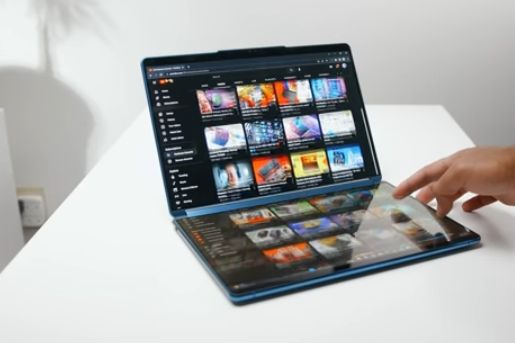
If you want to move an app from the main screen to the second one, just touch and drag the window with your fingers. A little menu will pop up, showing the second screen. If you hold the window for a bit longer, you’ll see different layouts for multitasking. To make an app cover both screens, tap the window with all five fingers, and it’ll show up in a big portrait layout, making web browsing smooth. But remember, you need to turn on this feature in the User Center app. Lenovo had to make special drivers for this laptop to work with Windows 11 because of its unique setup.
You May like this: ASUS ZenBook S13 OLED Review
Virtual Keyboard + Trackpad
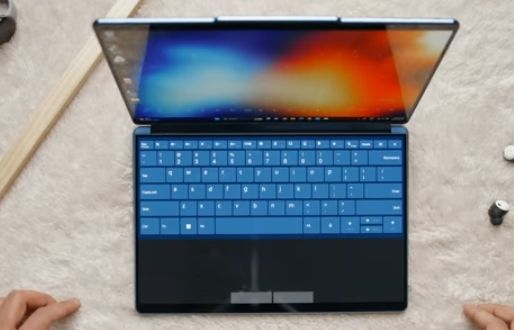
If you need a keyboard and trackpad, don’t worry, they’re virtual. Just tap the bottom screen with eight fingers, and a normal-sized keyboard will pop up. It also has a big trackpad that covers half the screen, along with virtual buttons.
I was pretty impressed with how well the trackpad works. It’s good at responding to touch, like when you’re selecting things or moving icons around. Lenovo even added a haptic motor that vibrates when you tap. But it’s not as precise as a regular glass trackpad and feels a bit resistant when you slide your finger, though it gets smoother with use.
The keyboard a neat idea and works fine for typing, but it’s not as good as a physical keyboard. I often accidentally hit the “p” and “backspace” keys together when I’m fixing typos. If you type a lot, you might not like it.
Physical Keyboard
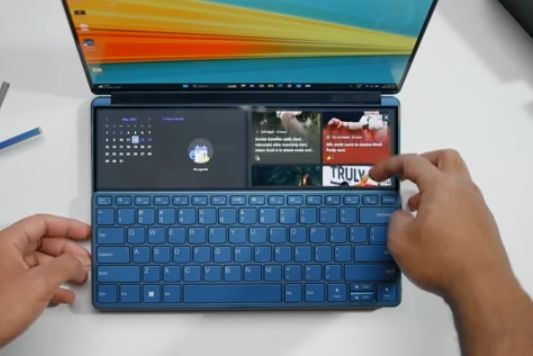
If the screen gets warm when you rest your hands on it, which can be uncomfortable, there’s an easy fix. You can use the external wireless keyboard that comes with the laptop and place it over the virtual keyboard. It fits perfectly and the laptop recognizes it right away, so you can start typing comfortably. I tried typing on both setups, and let me tell you, using a real keyboard feels much better. Just be aware that it might move a bit because of the glass surface underneath.
Since this keyboard is separate, it needs its own power. You can charge the physical keyboard using a USB Type-C cable and it lasts about a month on a single charge, which is pretty good. Plus, there’s a switch on it that lets you turn it off and reset the Bluetooth connection if needed.
Widget Bar
If you want more space on the screen, you can move the keyboard all the way down. But there’s a catch – it brings up something called the widget bar by default. This shows your Outlook calendar and top news for the day. Personally, I think it would have been better if Lenovo allowed third-party apps to use this space too, like Lightroom or Premiere Pro. It feels like a missed chance. Unfortunately, you can’t change what’s in the widget bar. You can turn it off and use it as a normal screen, but then apps might not work as well because of where the keyboard is.
Also, the 9i is missing some features Lenovo talked about, like the Smart Note functions. These let you quickly write notes on the lock screen, add bookmarks, or take screenshots with the stylus. Lenovo says these features will come later, but they haven’t said when.
Modes
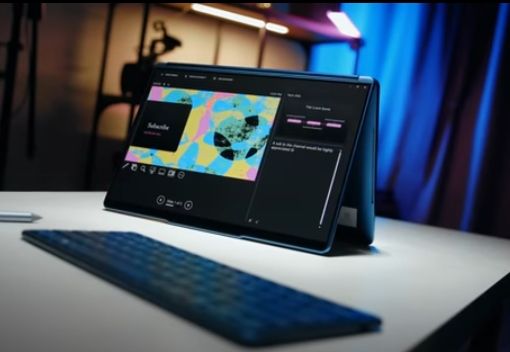
Lenovo Yoga Book 9i can transform into different modes, like laptop mode and tent mode. Tent mode is great for showing PowerPoint slides to people in front of you while you look at your notes. Right now, only PowerPoint works with this mode, and you can’t mirror the screens, which would have been handy.
Then, there’s book mode, perfect for using it like an actual book. You can have a PDF textbook on one screen and write notes on the other with the stylus. This is super helpful for students. But the special Notes app made for the Yoga Book isn’t available yet, so you’ll need other apps for now.
You can also use it as a tablet. In this mode, the second screen turns off, and the main screen is made for touching, giving you a normal tablet experience.
My favorite mode is the dual screen desktop layout. You fold the folio case that comes with it to make a stand, then attach the keyboard. This gives you a cool portable dual screen setup. You can use it in landscape or portrait mode. I like landscape for coding and other tasks because it’s comfortable and fits my workflow better. It’s less tiring than using it in regular laptop mode, where you’re always looking up and down between screens.
Productivity and Gaming

The dual screens are great for productivity. You can be on a Zoom call on one screen while taking notes on the other. If you’re making content, you can have your editing tools on one screen and your workspace on the other. Lenovo Yoga Book 9i is super helpful for editing lots of photos in Adobe Lightroom.
You can also play some games, but only older ones like Asphalt 9, Modern Combat, and Dungeon Hunter 5. Keep in mind, the laptop might not handle newer games well because of its specs.
The stylus that comes with it can be stored in a loop on the folio case, which is really handy. It’s always nearby and safe when you’re not using it.
Webcam and Speakers
It’s really good quality, with a 1080p sensor that gives clear and detailed images. The camera’s field of view is wide, so you can fit more in the frame. What’s cool is that the webcam is at the top of the screen, which is perfect when using the laptop in the dual screen setup. Instead of looking down at the camera, it’s right in front of you, making video calls more comfortable. Plus, you can easily tilt the screen down to show things from the top, like your phone or other objects.
There’s also a switch next to the power button that turns off the webcam for privacy.
The built-in speakers are great too. Lenovo put them at the front, so the sound comes straight at you, giving clear treble without distortion. The bass is good too, but not super powerful. Overall, the sound is better than laptops with speakers at the bottom, making videos and music more enjoyable.
Oh, and I suggest using a Bluetooth mouse with this setup. It’ll make your work a lot easier and more efficient.
Some Quirks
Despite its unique features, I ran into some issues while using this product. One of them is the sleep wake function. Instead of tapping the screen to wake it up like a regular laptop, you have to press a button near the bottom edge, which was a bit confusing. I accidentally turned off the device a few times while switching modes, which got frustrating. Also, when logging in, the virtual keyboard sometimes doesn’t show up, so you have to use the default Windows login screen.
Managing windows between the two screens isn’t always smooth. Sometimes, the menu to move a window to the second screen doesn’t show up, and I had to restart to fix it. I noticed a strange issue with DaVinci Resolve too. If you use the second screen for editing and the first for viewing, the video gets flipped. You can fix it by swapping the screens, but it’s annoying.
Another problem is that the app layout doesn’t reset when you use the virtual keyboard. So if you had an app open on the second screen and try to reopen it, it gets hidden under the keyboard. Also, keeping both screens clean from fingerprints was a hassle.
Luckily, most of these issues could be fixed with software updates. But I’m not sure if Lenovo will keep supporting this product for the next few years, especially if they release a new model in 2024.
Performance
After running some tests, here’s how the Lenovo Yoga Book 9i performs. In Geekbench 6, the scores for both single and multi-core tasks are surprisingly good, considering it has a U-series processor. Specifically, it’s got a Core i7 1355U with 10 cores (8 efficient ones and 2 powerful ones).
Now, this kind of processor isn’t meant for super high-end tasks, but it’s great for everyday stuff like using Microsoft Office, emailing, and browsing the web. The built-in Iris XE Graphics aren’t amazing for heavy-duty graphics work, but the laptop does have Thunderbolt 4 ports.
You can connect an external graphics card for better performance, but that’s extra money. Just remember, this laptop isn’t made for gaming or intense 4K video editing. You might be able to play some games if you lower the settings, but that’s not what it’s best at.
Battery Life
Having a low-power chip means better battery life, and I have to say, the Lenovo Yoga Book 9i impressed me in this area. So, I did a special test because this device has two screens. I played a 4K YouTube video on one screen while a web page kept refreshing on the other for 15 seconds. Surprisingly, the battery lasted for about 6 hours. I think that’s pretty good, especially since Lenovo claims it has an 81-hour battery life.
Final Thoughts
Lenovo is really pushing boundaries again with what I see as the follow-up to the Microsoft Surface Neo, that device with two screens that never made it to market. Here it is, and in the day or so that I’ve been using it, I’ve been pretty impressed.
But, I have to say, it might just be a device for a specific group of people. Not everyone needs two screens. It depends on what you do with your device. You’ll have to decide if it’s right for you.
For me, I like having that extra screen, especially when I’m trying to get a lot done, like when I’m editing videos and stuff like that. I can see it being useful. But, the $2,000 price might put some people off, and most people don’t need two screens.
Lenovo is definitely pushing the envelope once again with what I call the spiritual successor to the Microsoft Surface Neo, that ill-fated dual-screen device that never came to fruition.
- Design9
- Dual Screen9
- Keybords8.5
- Ports8
- Modes9
- Webcam8.5
- Speakers8
- Performance8.5
- Battery Life9

